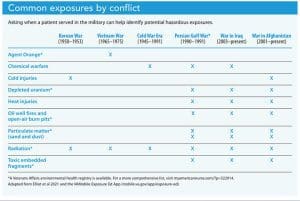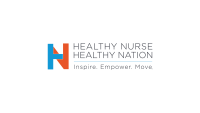Identify veterans and perform exposure assessments to improve care outcomes.
Takeaways:
- Many military service members access healthcare outside of the Veterans Health Administration, so nurses must take steps to identify them.
- Veterans have unique healthcare needs related to the effects of military service and hazardous exposures.
- Conducting a thorough hazardous exposure assessment that includes risk communication promotes high-quality, veteran-centered care.
To provide culturally sensitive care to veterans, nurses must understand how military service influences their health. However, healthcare organizations lack consistent mechanisms to identify veterans, which results in missed opportunities for related screening and triage.
Of military veterans seeking healthcare, 90% have concerns about the health effects of hazardous exposures, and more than half have symptoms without a clear cause that may be attributed to exposures. Most physical and visible injuries unrelated to exposures can be easily identified, whereas invisible injuries require additional screening to ensure appropriate assessment. Nurses should perform proper hazardous exposure assessments to aid in creating individualized care plans that address the unique health concerns of military service members and veterans.
Where do veterans receive care?
In 2020, the U.S. Census Bureau reported that approximately 18 million veterans live in the United States (about 7% of the U.S. population). Recent analysis of Veterans Affairs (VA) benefits and healthcare utilization shows that nearly 50% of those veterans seek care through the Veterans Health Administration (VHA), leaving approximately 10 million veterans seeking care in the community.
Various factors (such as nature of discharge from service and income thresholds) determine a veteran’s eligibility for care at the VA. Those eligible may still choose to seek care through community providers because of limited access in rural settings or personal preference. Among the veterans enrolled in VA care, many receive co-managed care from both VA and non-VA providers because of lower drug costs or lack of acute care services where they live. Challenges to co-managed care include fragmented care coordination, poor communication, and lack of accountability among healthcare teams.
Why is it important to identify military service?
Elliot and colleagues indicate that traditional nursing education lacks adequate curricula to provide culturally sensitive care in the veteran population. Many practicing clinicians report little understanding of military exposures and their health implications and that they’re ill-prepared to conduct individualized veteran-specific assessments and develop specific care plans.
In 2013, the American Academy of Nursing launched the campaign Have You Ever Served in the Military? to increase awareness of military service and its implications on a veteran’s health.
Always consider that a veteran’s physical ailments may be connected to their military service. Many current and former members of the military have mental health concerns, which require increased screening for depression and suicide. Mental health stigma remains a source of unease and barrier to care, but the stigma associated with seeking mental healthcare continues to decrease.
Unlike physical and mental health conditions, many veterans don’t include hazardous exposure concerns as part of their medical history unless prompted. This omission can be attributed to the veteran not recognizing or acknowledging a potential exposure or because they don’t understand the exposure. Many injuries associated with hazardous exposures are silent and develop over time. Consider Agent Orange exposure in Vietnam. The long-term sequelae took nearly 30 years to be acknowledged. Some of these health implications include chronic B-cell leukemias, type 2 diabetes, Hodgkin’s disease, non-Hodgkin’s lymphoma, multiple myeloma, Parkinson’s disease, prostate cancer, and other respiratory and soft-tissue cancers. Continued research has contributed to the 2021 addition of three new presumptive conditions related to Agent Orange: bladder cancer, hypothyroidism, and Parkinsonism.
Gender bias may be associated with women not being recognized as veterans and assessed appropriately. Women veterans have unique needs, and their exposure symptoms may present differently from their male counterparts. For example, according to research by Mohanty and colleagues, reports show that women who served in Gulf War I have higher instances of chronic multisymptom illness compared to men who served in that war.
How do you conduct an exposure assessment?
The VHA Office of Academic Affairs published a resource for providers on environmental exposures guided by Ask, Be informed, Create a care plan, and Discuss. Once a patient has been identified as a veteran, follow this guidance to ensure a thorough assessment and conduct risk communication.
Ask
Ask every military veteran if they have concerns about hazardous exposures. Gather information using the “Who, What, Where, When, How” technique. (See Ask the right questions.) Gather specific information to ensure an adequate assessment.
Ask the right questions
Ask these questions when assessing a veteran for environmental and hazardous exposures:
- Who
- Who was affected?
- What
- What were you exposed to?
- Did you experience any symptoms at the time of exposure?
- Did you use any personal protective equipment or any other precautions to minimize exposure?
- Did you receive any treatment?
- Where
- Where were you exposed? On a military base or during combat?
- When
- When were you exposed?
- How
- How were you exposed (inhalation, dermal, ingestion)?
- What was the length of the exposure?
- How concerned are you about the exposure?
Adapted from the U.S. Department of Veterans Affairs environmental exposure pocket card.
Many service members need additional prompting because they may not consider common experiences—such as sand, dust, or cold injuries—to be exposures. Ask for dates of service to help identify occupational and environmental exposures common to specific eras of military service. (See Common exposures by conflict.)


Be informed
Many resources can help increase awareness and knowledge of environmental exposures. Use them to ensure your discussions with veterans include individual exposure-related concerns and possible health effects. (See Exposure resources.)
Exposure resources
Use these tools to stay informed about veterans and hazardous exposures.
- American Academy of Nursing: Have You Ever Served? campaign: This resource provides a list of common military health risks to ask about during patient assessment. Learn more at haveyoueverserved.com.
- American Association of Colleges of Nursing: Access a tool kit to enhance veteran care and various resources for nurses caring for veterans and their families. Find out more at aacnnursing.org/Teaching-Resources/Tool-Kits/Veterans-Care.
- U.S. Department of Veterans Affairs: Veterans and healthcare providers can access this site for current information on military exposures by war and operation. Learn more at publichealth.va.gov/exposures/wars-operations/index.asp.
- VA Exposure Ed App: Access education on over 20 military-related exposures. Information can be found by exposure, date/location, or conflict. The app includes health implications and resources specific to each exposure. Download the app at mobile.va.gov/app/exposure-ed.
- War-Related Illness & Injury Study Center: This resource offers courses on the following topics:
- Airborne hazards
- Assessing deployment-related environmental exposures
- Chronic multi-symptom illness
- Depleted uranium and toxic embedded fragments
- Gulf War illness
Nurses employed with the Veterans Health Administration can complete courses at https://www.tms.va.gov/SecureAuth35. Non-VA nurses can register at train.org/main.
Create a care plan
When conducting a physical and health assessment, consider that exposures most commonly affect the integumentary, nervous, respiratory, and cardiovascular systems. Be aware that laboratory values or test results within normal limits don’t rule out the potential for exposure. For example, a normal chest x-ray doesn’t rule out exposure to particulate matter, airborne hazards, or burn pits. Some veterans may remain asymptomatic with normal test results for years or decades. Agent Orange is a good example of an exposure that took years for long-term sequelae to become evident. Promote healthy lifestyle behaviors (such as exercising, eating a well-balanced diet, and maintaining good sleep habits), and help patients reduce risk factors such as tobacco and alcohol use. Encourage routine follow-ups to monitor for changes in health, and evaluate for response to interventions. If a hazardous exposure is suspected, despite normal test results, monitor for symptoms, provide nursing interventions specific to that symptom, and continue to evaluate.
Discuss
Collaborate with the patient in risk communication to discuss health outcomes and consequences of exposure. The tone and direction of the conversation and a two-way dialogue are critical to establishing trust.
Start by asking appropriate open-ended questions and listening to the veteran’s response. The most effective communication occurs when you recognize the veteran’s concerns and provide an explanation that validates the veteran’s own perceptions and beliefs. Avoid dismissing the patient’s concerns, attributing them to a mental health condition, or simply agreeing with the veteran’s explanation.
Military exposure education and knowledge aids effective risk communication. For example, using phrases such as, “Here’s what we know,” provides factual information to veterans rather than negatives (such as, “There’s no indication,” or “There’s limited information”), which can be dismissive and vague.
Focus on the veteran’s goals to help them improve their own health, and be open to follow-up visits and care-plan adjustments. Risk may vary based on the individual and their military experience, so ask questions to assess their concerns about exposure and how their health, life, finances, and family are affected.
Also provide referrals to VA services and resources—such as apps, hotlines, and local care providers—that may benefit the patient. Encourage them to call the VA Special Issue Hotline (800-749-8387) for information on hazardous exposures and to contact their local VA environmental health coordinator about any health concerns they have related to military exposures. The patient may be eligible for registry evaluations even if they’re not enrolled in VA healthcare.
Exposure health registries
The Department of Veterans Affairs (VA) offers a variety of free, voluntary registries for veterans who have health concerns related to exposures during their military service. They don’t need to be enrolled in VA healthcare, but the programs have eligibility requirements. Encourage veterans to contact their local VA medical center’s environmental health coordinator (which can be found at publichealth.va.gov/exposures/coordinators.asp). The coordinator facilitates the enrollment process and manages registry health exams to help identify health concerns and facilitate future testing if indicated. Registry enrollment promotes research to improve current VA healthcare and increases awareness of possible long-term consequences to military-related exposures. Explain to patients that participation in these registries doesn’t enroll them in service-connected disability compensation and pension.
Available registries include the following:
- Agent Orange Registry
- Airborne Hazards and Open Burn Pit Registry
- Depleted Uranium Follow-up Program
- Gulf War Registry
- Ionizing Radiation Registry
- Toxic Embedded Fragment Surveillance Center
Help solve the puzzle
Regardless of practice location, nurses must understand the implications of military service on a veteran’s health and assess for exposures and potential health concerns. Research on this topic continues to grow. For example, in August 2021, the VA added asthma, rhinitis, and sinusitis as presumptive conditions related to particulate matter exposure, including the long-debated hazards related to oil well fires, open-air burn pits, sand, and dust. However, the long-term health implications from recent exposures are poorly understood and warrant further research.
To ensure delivery of culturally sensitive care, undergraduate and graduate nursing school curriculum must include education in veteran and military healthcare. Nurses in all settings should receive additional training on the impact of military service and the associated health risks of this vulnerable population. Being unaware of how hazardous exposures may impact a veteran’s health could result in misdiagnosis or a missed diagnosis. When you conduct a hazardous exposure assessment that includes risk communication, you may identify symptoms that reveal the missing puzzle piece needed for the veteran to progress on their journey toward optimal health.
Andrea Kossoudji is a patient-aligned care team RN care manager at VA San Diego Healthcare System in San Diego, California. Julie Scott is a specialty clinic RN at VA Western New York Healthcare System in Buffalo.
References
American Association of Colleges of Nursing. Enhancing veterans’ care faculty tool kit. aacnnursing.org/Teaching-Resources/Tool-Kits/Veterans-Care
Baldwin N, Rudquist RR, Lava-Parmele S, Trembley JH, Butterick TA, Bach RR. Improving health care for veterans with Gulf War illness. Fed Pract. 2019;36(5): 212-9.
Elliot B, Chargualaf KA, Patterson B. Veteran-Centered Care in Education and Practice: An Essential Guide for Nursing Faculty. New York City, NY: Springer Publishing; 2021.
Hall AL, MacLean MB, VanTil L, McBride DI, Glass DC. Considering exposure assessment in epidemiological studies of chronic health in military populations. Front Public Health. 2020;8:577601. doi:10.3389/fpubh.2020.577601
Key words: veterans, hazardous exposure, healthcare, military service


















